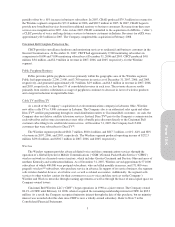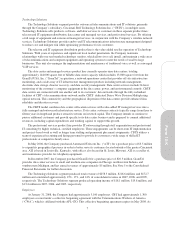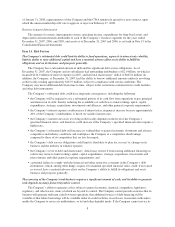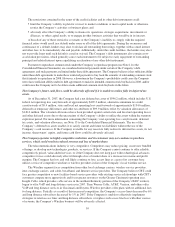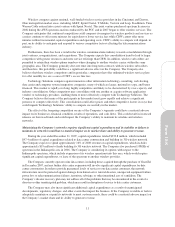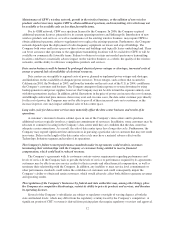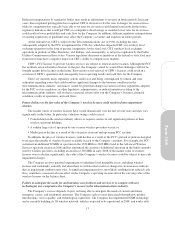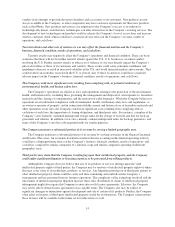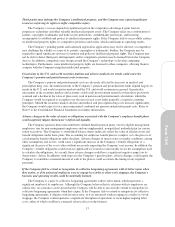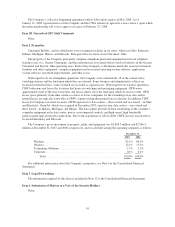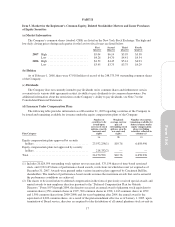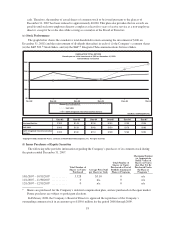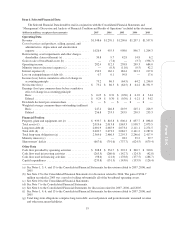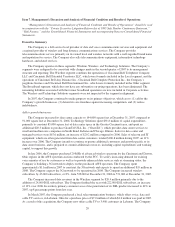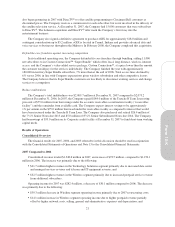Cincinnati Bell 2007 Annual Report Download - page 92
Download and view the complete annual report
Please find page 92 of the 2007 Cincinnati Bell annual report below. You can navigate through the pages in the report by either clicking on the pages listed below, or by using the keyword search tool below to find specific information within the annual report.Maintenance of CBW’s wireless network, growth in the wireless business, or the addition of new wireless
products and services may require CBW to obtain additional spectrum, and transmitting sites which may not
be available or be available only on less than favorable terms.
For its GSM network, CBW uses spectrum licensed to the Company. In 2006, the Company acquired
additional spectrum licenses, primarily for its current operating territory and Indianapolis. Introduction of new
wireless products and services, as well as maintenance of the existing wireless business, may require CBW to
obtain additional spectrum, either to supplement or to replace the existing spectrum. Furthermore, the Company
network depends upon the deployment of radio frequency equipment on towers and atop of buildings. The
Company both owns and leases spaces on these towers and buildings and typically leases underlying land. There
can be no assurance that spectrum or the appropriate transmitting locations will be available to CBW or will be
available on commercially favorable terms. Failure to obtain or to retain any needed spectrum or transmitting
locations could have a materially adverse impact on the wireless business as a whole, the quality of the wireless
networks, and the ability to offer new competitive products and services.
Data center business could be harmed by prolonged electrical power outages or shortages, increased costs of
energy or general lack of availability of electrical resources.
Data centers are susceptible to regional costs of power, planned or unplanned power outages and shortages,
and limitations on the availability of adequate power resources. Power outages, such as those that occurred in
California in 2001, the Northeast in 2003, and from the tornados on the east coast of the U.S. in 2004, could harm
the Company’s customers and business. The Company attempts to limit exposure to system downtime by using
backup generators and power supplies; however, the Company may not be able to limit the exposure entirely even
with those protections in place. In addition, global fluctuations in the price of power can increase the cost of energy,
and although contractual price increase clauses may exist and, in some cases, the data center customer pays directly
for the cost of power, the Company may not be able to pass all of these increased costs on to customers, or the
increase in power costs may impact additional sales of data center space.
Long sales cycle for data center services may materially affect the data center business and results of its
operations.
A customer’s decision to license cabinet space in one of the Company’s data centers and to purchase
additional services typically involves a significant commitment of resources. In addition, some customers may be
reluctant to commit to locating in the Company’s data center until they are confident that the data center has
adequate carrier connections. As a result, the sale of data center space has a long sales cycle. Furthermore, the
Company may expend significant time and resources in pursuing a particular sale or customer that may not result
in revenue. Delays in the length of the data center sales cycle may have a material adverse effect on the
Technology Solutions segment and results of its operations.
The Company’s failure to meet performance standards under its agreements could result in customers
terminating their relationships with the Company or customers being entitled to receive financial
compensation, which could lead to reduced revenues.
The Company’s agreements with its customers contain various requirements regarding performance and
levels of service. If the Company fails to provide the levels of service or performance required by its agreements,
customers may be able to receive service credits for their accounts and other financial compensation, as well as
terminate their relationship with the Company. In addition, any inability to meet service level commitments or
other performance standards could reduce the confidence of customers and could consequently impair the
Company’s ability to obtain and retain customers, which would adversely affect both ability to generate revenues
and operating results.
The regulation of the Company’s businesses by federal and state authorities may, among other things, place
the Company at a competitive disadvantage, restrict its ability to price its products and services, and threaten
its operating licenses.
Several of the Company’s subsidiaries are subject to regulatory oversight of varying degrees at both the
state and federal levels, which may differ from the regulatory scrutiny faced by the Company’s competitors. A
significant portion of CBT’s revenue is derived from pricing plans that require regulatory overview and approval.
12





